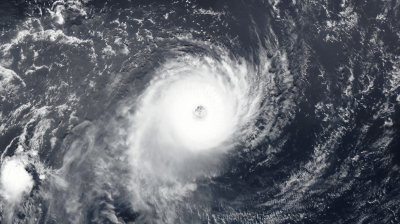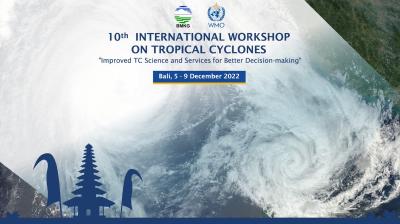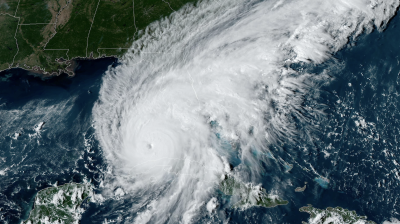Climate change likely increased intense rainfall in Pakistan: study
Human-caused climate change likely increased the intense rainfall that flooded large parts of Pakistan, according to rapid attribution analysis by an international team of leading climate scientists as part of the World Weather Attribution group. Extreme rainfall in the region has increased 50-75% and some climate models suggest this increase could be entirely due to human-caused climate change, although there are considerable uncertainties in the results. The Government estimates that around 33 million people across the country are affected by the rains, floods and impacts such as landslides, killing at least 1,100 people and destroying infrastructure, homes, agricultural land and livestock.

Human-caused climate change likely increased the intense rainfall that flooded large parts of Pakistan, according to rapid attribution analysis by an international team of leading climate scientists as part of the World Weather Attribution group. Extreme rainfall in the region has increased 50-75% and some climate models suggest this increase could be entirely due to human-caused climate change, although there are considerable uncertainties in the results.
The Government estimates that around 33 million people across the country are affected by the rains, floods and impacts such as landslides, killing at least 1,100 people and destroying infrastructure, homes, agricultural land and livestock. The human and socio-economic toll is expected to increase as flood levels continue to rise, with immense pressure on the country's dams. The United Nations Office for the Coordination of Humanitarian Affairs (OCHA) launched a flash appeal on 30 August for US $160.3 million to help victims of the monsoon flooding. More than 70 districts were declared “calamity hit” by the government of Pakistan.
“[We] have all seen media images of the extraordinary destruction. I can only imagine the power and ferocity of the water as it bore down on villages, roads, bridges and everything else in its path. It was clearly terrifying – a wall of water,” UN Secretary Antonio Guterres said during a visit to the country on 9-10 September. “No country deserves this fate, but particularly not countries like Pakistan that have done almost nothing to contribute to global warming.”
The Pakistan Meteorological Department said that it was the wettest August since records began in 1961. National rainfall was 243 percent above average. In the province of Balochistan, it was +590 percent and in Sindh +726%, according to the monthly report.The Indus river, which runs the length of the country, burst its banks across thousands of square kilometres, while the intense local rainfall also led to urban flash floods, landslides and glacial lake outburst floods.
World Weather Attribution study
To quantify the effect of climate change on the heavy rainfall, the World Weather Attribution scientists analysed weather data and computer simulations to compare the climate as it is today, after about 1.2°C of global warming since the late 1800s, with the climate of the past, following peer-reviewed methods. The researchers focused on two aspects of the event: the 60-day period of heaviest rainfall over the Indus river basin between June and September, and the 5-day period of heaviest rainfall in Sindh and Balochistan.
Fahad Saeed, Researcher at the Center for Climate Change and Sustainable Development, Islamabad, Pakistan, said: “Fingerprints of climate change in exacerbating the heatwave earlier this year, and now the flooding, provide conclusive evidence of Pakistan’s vulnerability to such extremes."
The scientists found that modern climate models are not fully able to simulate monsoon rainfall in the Indus river basin, as the region is located at the western edge of the monsoon and its rainfall pattern is extremely variable from year to year. Consequently, they could not quantify the influence of climate change as accurately as has been possible in other studies of extreme weather events, such as heatwaves and heavy rainfall in areas with less variability and more reliable models. For the 5-day total rainfall, some models suggest that climate change increased the 5-day total rainfall in Sindh and Balochistan by up to 50%. This is in-line with recent IPCC assessments projecting more intense rains in the region and with historical weather records which show that these heavy rainfall episodes have increased 75% in the region in the last few decades. There were large uncertainties in climate modelling of maximum 60-day rainfall in the Indus basin, meaning the scientists were not able to estimate the influence of climate change on this aspect of the rainfall.
Friederike Otto, Senior Lecturer in Climate Science at the Grantham Institute - Climate Change and the Environment, Imperial College London, said: “ What we saw in Pakistan is exactly what climate projections have been predicting for years. It’s also in line with historical records showing that heavy rainfall has dramatically increased in the region since humans started emitting large amounts of greenhouse gases into the atmosphere. And our own analysis also shows clearly that further warming will make these heavy rainfall episodes even more intense."
The Pakistan Meteorological Department has issued repeated accurate warnings about rainfall, flooding and landslides, using WMO Flash Flood Guidance System warning products in in addition to national and regional analysis to disseminate to the relevant national stakeholders as well as to the local population. The National Disaster Management Authority is also issuing regular updates on river flood. Without these warnings, the death toll would most likely have been even higher.
WMO has also provided briefings and forecasts to the humanitarian sector and joins the rest of the international community in offering condolences.
In a video message, UN Secretary General Antonio Guterres said that “the people of Pakistan face the unrelenting impact of heavy rains and flooding – worst in decades. The scale of needs is rising like the flood waters. It requires the world’s collective and prioritized attention.”
At the ceremony to launch the appeal, Pakistan’s Minister for Planning Ahsan Iqbal highlighted that “Pakistan being a negligible contributor to the overall carbon footprint, is still among the top ten countries that are vulnerable to climate change, and with extreme weather events which we have experienced from earlier this year like the heat waves, forest fires, multiple glacial lake-outburst-floods and now these disastrous monsoon floods.”
In March to May this year, Pakistan was gripped by a devastating heatwave, which impacted water supplies, health, agricultural output and the economy, and caused rapid glacier melt. A rapid attribution survey said climate change made the extreme heat 30 times more likely.
August rainfall

The number of rainy days is also much higher than normal at most stations in Sindh and Balochistan as well as in northern regions such as Khyber Pakhtunkhwa and Gilgit-Baltistan provinces. For example, In Sindh, various stations received 10-17 days of rainfall, compared to the 1-3 normal rainy days. In addition, many 24-hour historical rainfall record were broken - one particular site at Padidan (Sindh province) reported 1228 mm monthly rainfall (as of 30 August) compared to the average monthly rainfall of 46 mm. The same station also reported 355 mm of rain in 24-hour on 19 August.
Many areas in southern Pakistan are already under water. The recent flooding in north Pakistan, especially in the mountainous Khyber Pakhtunkhwa province, threatens to aggravate the flood crisis in the coming days and weeks.
The National Disaster Management Agency is issuing daily situation reports on monsoon flooding on its website. The River Kabul flow at Nowshera has seen the highest inflow in recent years. This is based on river flow charts from the Pakistan Meteorological Department’s Flood Forecasting Division.
UN agencies warned that the flooding disaster would have lasting and widespread repercussions – for instance on the large refugee population, on health facilities and vaccination campaigns. Livelihoods are also being heavily impacted – more than 719,000 livestock – a critical source of sustenance and livelihoods for many families – have died, of which some 69 per cent are in Balochistan and 28 per cent in Punjab. Around 2 million acres of crops and orchards have also been affected to date, of which 304,475 acres are in Balochistan, 178,186 acres in Punjab and around 1.54 million acres in Sindh, according to OCHA’s Response Plan issued on 30 Aug.
Pakistan is no stranger to disastrous floods. Devastating floods in 2010 caused massive destruction and loss of life due mainly to very heavy rains in north of Pakistan which caused firstly flash floods and then riverine flooding from north to south Pakistan.
The ongoing disaster demonstrates once again the need for climate change mitigation and adaptation. It also highlights the importance of WMO’s drive to ensure universal access to early warnings which drive Anticipatory Action through the UN Alerts for all initiative and its integrated flood management and flash flood guidance tools. Anticipatory Action, alongside an understanding of forecast uncertainty is proven to be highly effective, providing life saving benefits to communities around the world.
- WMO Member:
- Pakistan










